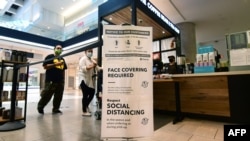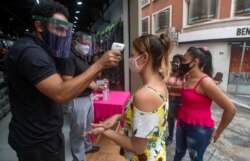Every day for the past two weeks, roughly 900 people have died of COVID-19 in the United States. The case count has been stuck at about 20,000 per day.
That's down from the peak in mid-April, when more than 2,000 were dying and more than 30,000 were testing positive every day.
But progress on controlling the epidemic has stalled.
Stay-at-home orders; closing restaurants, bars and theaters; and canceling large gatherings succeeded in slowing the spread of the coronavirus that causes COVID-19.
In epidemiological terms, the curve flattened. But as the country comes out of lockdown, the curve is staying flat, at a time when health officials say it needs to be curving downward.
Summer headwinds
Weather is working against the virus for now. Summer's warmth and humidity seem to tamp down, but not eliminate, the risk of infection.
The trend will reverse beginning in late August and September. Climate conditions will begin to tilt in favor of the virus, and the expected second wave will begin.
"It's very important during the summer season, when the seasonality is going to our advantage, to make sure we do it right," said health metrics sciences professor Ali Mokdad at the University of Washington Institute for Health Metrics and Evaluation.
That means "that we keep our guard (up) and we reduce the circulation of the virus to as low as possible," he said in an interview.
Much of the United States is lowering its guard, however.
Reopening and resurgence
All 50 states have begun relaxing restrictions and reopening businesses.
At the same time, several states have seen increases in the number of new cases.
But not every state that has reopened has seen an uptick. Experts don't know why cases in Arizona have spiked while cases in Georgia have plateaued, for example.
"Somehow, states that have reopened and have not seen a resurgence are doing something right," University of Arizona associate professor of public health policy management Joe Gerald said in an interview.
"If we just knew what that was, then we could replicate it in other states and maybe get on with our lives and do as little economic damage to our economy as possible," he added. "I just don't think we have it yet."
Wear a mask
Masks could be one factor.
Evidence keeps piling up that they can make a significant dent in transmission rates.
Wearing a mask is the "simplest, most effective option" for keeping infection numbers down, Harvard University epidemiology professor Michael Mina said in a briefing for reporters. "There's no doubt about that."
But masks – even masks – have become a political issue.
One poll found Democrats are nearly twice as likely as Republicans to wear one every time they leave the house.
Testing and tracing
To control the disease, public health officials must know who has it. After a botched start, testing for coronavirus infection has ramped up over the past few months.
But capacity is patchy across the country. Experts suggest that states are doing enough testing when 5 percent come back positive, but nearly half of states have not reached that threshold.
When patients test positive, health officials then need to find out who else they may have infected and get those people tested and isolated, too. Public health officials called for an army of more than 100,000 contact tracers to do the job.
Despite a wave of hiring in the past month, "we're nowhere near the levels" needed, said government affairs chief Adriane Casalotti at the National Association of County and City Health Officials.
Vaccines
Ultimately, a vaccine will be needed to bring the pandemic to an end. Scientists are racing to produce a safe and effective vaccine by early next year, an unprecedented pace.
The World Health Organization tallies 10 candidates currently in human testing and 126 in preclinical studies. One vaccine, from the University of Oxford, is beginning late-stage testing. Biotech company Moderna says it will start its final stage of testing next month.
To make a vaccine available as soon as possible, several companies, with backing from various governments and public-private partnerships, are scaling up manufacturing before they know if any of them work.
Treatments
Only one drug so far has worked against COVID-19, and its benefits are limited. Remdesivir, from pharmaceutical company Gilead, shortened hospital stays for COVID-19 patients in one study. It did not have a significant impact on saving lives, however.
The anti-malaria drug hydroxychloroquine gained attention early in the pandemic, but it has not yet proved its usefulness.
Small, preliminary studies of patients in France and China showed some promise. With nothing else available to treat COVID-19, doctors around the world have given thousands of patients the drug without knowing if it works.
Though experts cautioned that the research was far from conclusive, U.S. President Donald Trump and some of his conservative allies said hydroxychloroquine could be a "game changer" based on the early research. Trump said he took it to prevent infection.
But a study found it did no better than a placebo at preventing health care workers and others at high risk of infection from developing COVID-19.
Whether it helps to treat the disease remains an open question. One recent study suggested it does not, but it was retracted after the data came under question. Other research is under way in the United States and internationally.
Several other treatments are under study, including anti-HIV drug combination lopinavir–ritonavir, and antibodies from COVID-19 patients who have recovered.








